appearance and variability of individuals seen on migration in South Korea
This first note focuses on Brown Shrike Lanius cristatus. It was prompted by noting differences between Brown Shrike seen in the field and descriptions of the species contained in available literature, and by subsequent discussion over the possible difficulty of some individual’s separation from Isabelline Shrike L. isabellinus (with lesser attention given to Red-backed Shrike L. collurio, a species first recorded in South Korea in September 2004. Go to Red-backed Shrike for details).
Based on a series of images (taken in May and September 2003 and especially in May 2004), this note
- contains comments on the status and appearance of various subspecies of Brown Shrike in Korea (based primarily on mantle/back coloration)
- helps to illustrate at least some of the variability in their appearance
- contains a brief review of criteria often cited for separating adult Brown from Isabelline Shrike (with lesser attention given to Red-backed Shrike L. collurio)
- provides images of "typical" individuals of Brown and Isabelline Shrikes (the latter from Oman and Kazakhstan)
- and provides images of individual Brown Shrike that appear to show one or more of three main features considered atypical for Brown Shrike but typical of Isabelline (namely a white patch on the base of the primaries, pale lores in females, and orange-toned tails). Importantly, the existence and frequency of such individuals raises questions over the confidence put in some widely-used identification criteria for both species.
The note concludes that significant further research needs to be conducted before identification criteria (or even taxonomic decisions) can be fully determined for the Brown Shrike taxa, and by extension Isabelline Shrike taxa, and that extreme caution needs to be used when identifying "atypical" extralimital shrikes of either species.
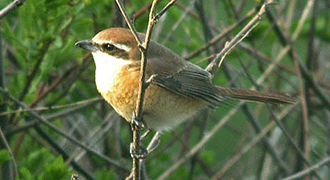
South Korea, May, © Nial Moores
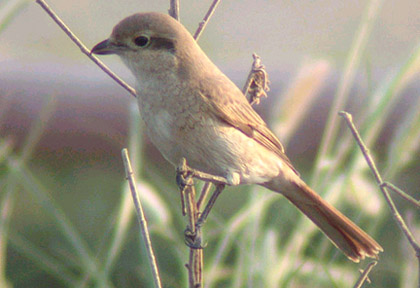

Iran. April, © Bjorn Johansson.
The Brown Shrike: Taxonomy and Distribution
The Brown Shrike is an East Asian species, breeding primarily in eastern Siberia, China, Mongolia, the Koreas and Japan, and overlapping with Isabelline Shrike in central Asia where hybridization between the two species (and between Red-backed and Isabelline) occurs (e.g. Worfolk 2000, Svensson 2003). The northernmost wintering limit is southern China and southernmost Japan, and the species becomes widespread in the boreal winter throughout much of South-east Asia. It appears prone to vagrancy, and has been recorded in Australia (first accepted on Christmas Island in 1988), Western Europe (apparently ca 8 times between 1985 and 2003), and North America (first in 1977: Gibson, 1981).
Brown Shrike is comprised of either four (Svensson, 1992) or three distinct subspecies, considered by Worfolk (2000) as worthy of treatment as three diagnosable species under the phylogenetic species concept: L. cristatus, L. lucionensis and L. superciliosus. All taxa are considered to be somewhat variable in appearance, with apparently numerous intergrades and some hybridisation. The fourth form, confusus, Worfolk (2000) concludes may represent the introgression of lucionensis genes into cristatus, and requires further research. This note agrees that more research is required, and basing an opinion on the difficulties of identifying many individuals to subspecies in the field, follows the more conservative Svensson (1992) and Robson (2000) in treating Brown Shrike as a single species, with four subspecies (the clearly diagnosable nominate cristatus, lucionensis, superciliosus and the somewhat enigmatic and poorly-described confusus).
According to Worfolk (2000), nominate cristatus breeds in eastern Siberia, from the Russian Altai and Ob River eastward through northern and eastern Mongolia to the Pacific. The disputed type confusus occurs in the south-eastern part of this range (in the Amur and Ussuri basins) and is the type recorded breeding in Heilongjiang and far north-eastern Inner Mongolia, China (also possibly in North Korea: Fiebig per Tomek, 2002). Superciliosus breeds only in Sakhalin and Hokkaido, south to central Honshu (Japan) and lucionensis breeds throughout most of eastern China, from Hebei and Shanxi south to Guangdong and west to Sichuan, as well as in southern Japan and the Korean peninsula.
The Brown Shrike: Status in South Korea
The Brown Shrike, of the subspecies lucionensis, was considered by Tomek (2002) to be a "common breeding species throughout" DPRK (though she notes that Fiebig suggested that the coloring of all birds he saw was typical of confusus). This status assessment was based largely, it appears, on the specimen record and earlier accounts, as it is now largely contradicted by more recent experience: " Brown Shrike is now pretty rare in DPRK: I probably saw fewer than a dozen outside breeding territories in 5 years; and a maximum of three territories in any one year" (W. Duckworth. in lit., 2004).
In the South, lucionensis is now considered to be a much-decreased and comparatively uncommon (and local) summer visitor. It is considered by Worfolk (2000) to be found in winter as far north as southern Korea. However, there are no mid-winter records of lucionensis known to Birds Korea, with the latest records traced being two old specimens in the DPRK said, perhaps in error, to have been collected in November (reported in Tomek, 2002).
The greatest concentrations of Brown Shrike, of all three or four subspecies, are therefore of migrants on offshore islands from late April to early June and again, in rather smaller numbers, in August and September, with occasional individuals into October. As might be expected, in spring the majority of earlier-migrating individuals tend to be males, followed by females and finally second calendar year birds, though there appears to be significant overlap, as also might be expected considering the asynchronous migration strategies of the various subspecies and the presumed wide geographical area over which such birds might be breeding. In autumn, many individuals seen on offshore islands are juveniles and first winters ("first years").
Personal observations since 2000 include day peaks of less than 10 individuals on the far southwestern island of Gageo (e.g. in May 2000 and 2001), with rather larger numbers found northward (e.g. on Socheong Island in the far northwest, peak counts in spring and autumn 2004 were 75 on May 17th, and 55 on August 19th). Lucionensis comprise probably 30-50% of all Brown Shrike during early May, with the vast majority (90%) comprised of this taxon by late May/early June. This includes lucionensis types with much brown admixed into the crown (considered by Worfolk [2000] to be better described as the intergrade confusus).
Superciliosus is, by contrast, the scarcest of the four forms, with a very few records of single birds, mostly in May in the far southwest.
The remainder are comprised largely of either cristatus or confusus, "reddish-brown backed" types. In autumn, many juveniles and first years are very difficult to ascribe confidently to subspecies.
Identification
"Typical" Brown Shrike adults in spring range in appearance from brown-backed (lucionensis) through reddish-brown backed (cristatus and presumably confusus) to reddish (superciliosus); grey-crowned (lucionensis) to reddish crowned (superciliosus); with broad, white supercilium (superciliosus) to almost no supercilium (lucionensis); with whitish underparts (superciliosus) to saturated orange and buff below (cristatus and probably confusus).

Although highly variable, most Brown Shrike are easily separated from Bull-headed Shrike by structural and plumage differences. However, their structure is largely shared by Isabelline Shrike. On left, female lucionensis (probably first summer); on right, a "sandy-backed" individual, probably confusus, close in upperpart coloration to some Isabelline.

Despite this extreme variability, Brown Shrike can easily be separated from the widespread Bull-headed Shrike L. bucephalus on account of structural differences including Brown’s longer, fuller tail and heavier bill, by the blackness of the lores and ear coverts and the lack of grey tones in much of the upperparts (with the exception of the crown in lucionensis), and in many individuals by the presence of a rather well-marked supercilium.
Separation from the various taxa of Isabelline Shrike is potentially significantly more problematic. Although unrecorded on the Korean peninsula, Isabelline Shrike has been recorded further east in Japan (in Okinawa Prefecture, on February 17th 2003: per Akiyo Nakamichi in lit., 2004), highlighting the possibility of vagrancy.
Like Brown, Isabelline Shrike is also considered variably as three full species using the phylogenetic species concept (e.g. Worfolk, 2000), or as three subspecies with complete gradation between populations (Svensson, 2003), the latter noting that: "It’s not only that 75% of the females and even more juveniles are indistinguishable, many males show a frustrating mix of characters". Upperpart coloration of Isabelline Shrike varies from pale grey-brown (isabellinus) to reddish (phoenicuroides); underpart coloration from whitish (phoenicuroides) to richly saturated buff (isabellinus); while two subspecies tend to show obvious white patches at the base of the primaries (especially adult male isabellinus and phoenicuroides), while a third (arenarius) does not. All subspecies tend to show orangey rumps and uppertail (leading to the alternate name of Rufous-tailed Shrike), which used in combination with other features (many of which are described below) makes separation of most individual Isabelline Shrike from Brown Shrike straightforward.
However, a significant number of Brown Shrike occur in South Korea (and presumably elsewhere) which seem to show features suggestive of one or more forms of Isabelline. It is presumably individuals such as these (in addition to some phoenicuroides Isabelline Shrike especially) that led Svensson (1992) to conclude that Brown Shrike is "very similar to L. isabellinus". Confident identification of some individuals is even further complicated by hybridization between Isabelline and both Red-backed L. collurio and Brown Shrike in Central Asia at least (e.g. Svennson et al, 2003) - for an online comment with photographs of apparently hybrid pairs in Kazakhstan which illustrates this point go to Hybrid Shrikes in Central Asia.
Allowing for the great variability in both Isabelline and Brown Shrike, reference to Svensson (1992), Svensson et al (1999), and Worfolk (2000) suggest that the vast majority of adults should still be safely separable on the basis of the following main criteria:
Three out of four subspecies of Brown Shrike show reddish or reddish-brown upperparts and strongly yellow-buff ventrally and on the flanks, while all subspecies of Isabelline Shrike except phoenicuroides show sandier or grayer tones to the upperparts. With the exception perhaps of isabellinus most Isabelline also have rather less saturated coloration on the underparts than most Brown.
The tail tends not to be strongly contrasting in Brown Shrike (often similar in coloration or darker than the rest of the upperparts), whereas it tends to be contrastingly and often distinctively orange-toned in most individuals of Isabelline Shrike. Svensson (1992) notes, however that "some females [subspecies ’isabellinus’] have rather dull dark brown tails with practically no rufous tinge at all".
Most adult male (except arenarius apparently) and some female Isabelline tend to show quite a strong white patch at the base of the primaries. No Brown Shrike of any subspecies, sex or age it is said (though see below) should show extensive white at the base of the primaries (to quote from Svensson [1992]: "bases to primaries only very rarely with some white [only 0-2 mm longer than the primary coverts if any]".
Many adult Isabelline, especially in the eastern part of the range, tend to show paler lores, contrasting with darker ear coverts (with arenarius females also showing very poorly marked ear coverts too), whereas most Brown Shrike, male and female, have dark lores. All adult male Brown Shrike should show black lores and a "jet black face mask", and while nominate cristatus female "never" shows black lores or black nostril feathering…(the) face mask can be rather black in some" (Svennson, 1992). The vast majority of adult, and even second calendar year Brown Shrike females of all subspecies are believed to show either dark brown or blackish lores.
Many adult Isabelline (with the exception of "western" phoenicuroides) show obviously paler bills basally than Brown Shrike. The bills are invariably largely or completely dark in adult Brown, though occasionally paler-based in second-calendar year birds and also (some?) adults in winter (e.g. Worfolk, 2000);
Various in-the-hand differences noted by Svensson (1992) include tail width, longer and stronger rictal bristles in Brown Shrike, and slight differences in wing formulae, while other plumage minutiae include the greater tendency of Brown to show a more graduated tail shape, obvious growth bars in the tail, and buffy tips to the 5th and 6th pair of tail feathers. However, several of these latter features apparently can also be shown by Isabelline to a varying degree and not be shown by Brown (!).

The Appearance of Brown Shrikes in South Korea
A significant number of Brown Shrike seen in South Korea in spring do not conform well with the plates of Brown Shrike in Worfolk (2000) or Robson (2000).
Due to this discrepancy, the variability of appearance, and the lack of in-the-hand data, this note lumps individuals seen into three sub-groups for convenience of description (and NOT as a reflection of taxonomic or geographic considerations):
"brown-backed" (lucionensis or close to lucionensis)
"reddish-backed" superciliosus, presumably some confusus, and many cristatus
"sandy-backed" individuals of unclear provenance (perhaps also largely attributable to confusus?).
1) "Brown-backed" lucionensis
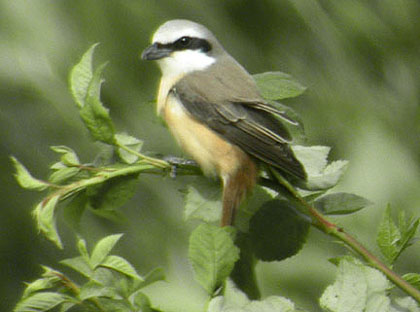
Grey-crowned, brown-backed, rufous tailed, and orangey-buff underparts: arguably the most attractive of the Brown Shrikes.
Adult lucionensis is the most distinctive and arguably the most attractive-looking of the subspecies of Brown Shrike occurring in South Korea, appearing rather distinct from Isabelline Shrike. While very similar to "reddish-backed" subspecies in structure and behaviour, most lucionensis nonetheless seem rather more approachable and prone to perching in the open, and in addition most appear to show a rather square-cut tail, seeming to lack the slight gradation shown by many, but not all, "reddish-backed" birds. Most also appear to show between 5 and 6 primaries beyond the longest tertial on the closed wing, similar to the vast majority of individuals of other Brown Shrike subspecies - despite being considered mostly a medium-range migrant by Worfolk (2000).
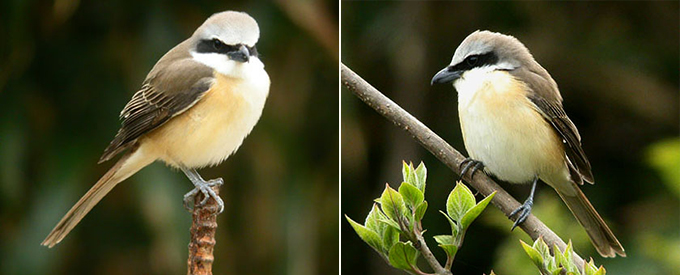
Note the square-ended tail, very poorly marked supercilium, and slight black extending over the bill. Individuals such as this are considered by some to be confusus or intergrades, based on the grey of the crown being admixed with brown. Most lucionensis in South Korea show a similar crown colouration.
Both sexes (especially in spring) appear obviously dark and cold-toned brown in the upperparts, with strikingly clean pale fringes to the tertials (often more marked on the outer edge), and a more warmly-colored rump and base to the tail (often darkening distally). A very few individuals (less than 1%, and these perhaps intergrades) show some white at the base of the primaries. Presumed males have rather extensive ash-grey crowns (palest, even whitish, on the forecrown), and this contrasts strongly with solidly black ear coverts and lores, with the black extending thinly up to and above the bill. The supercilium is often rather poorly marked and suffused with grey, though sometimes it can be more prominent and whitish. Most of the underparts are typically saturated with warm yellow-buff, tinged more strongly apricot on the flanks. Females appear rather similar to males, though perhaps look a little colder-brown, and some seem to show rather more brown admixed into the crown (though this could also perhaps reflect intergradation with other subspecies: if so more than 50% of all later-migrating lucionensis in spring in South Korea show some such intergradation). Some females also show rather browner tones to the ear coverts and lores, and occasionally some vermiculations on the underparts. Many birds considered to be adult female do not show strong underpart barring, while second calendar year birds can perhaps be aged by a combination of stronger vermiculations on the breast sides and flanks, and poorly-marked lores. Bills of full adults are invariably black or blackish, while presumed second calendar year birds also occasionally show slightly paler bills basally.
2) "Reddish-backed" subspecies
The majority of non-lucionensis Brown Shrike in South Korea have reddish-brown backs/mantles, rufous-brown crowns, and warm-tinged brown tails. A very few adults (perhaps less than 1%) are distinctly brighter and cleaner-looking, redder above, and show a very strong black face-mask, an obvious supercilium, and a broad white forehead. Based on the combination of these features, such individuals can easily be ascribed to the Japan- and Sakhalin-nesting superciliosus. Superciliosus can further be differentiated by its cleaner underparts, with most of the buff wash on the underparts confined to the flanks, and its slightly longer bill.
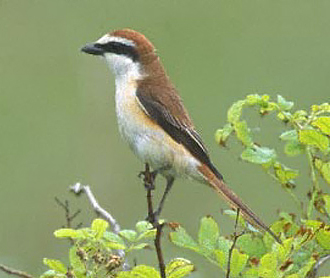
For more of Mike´s images go to www.avesphoto.com.)
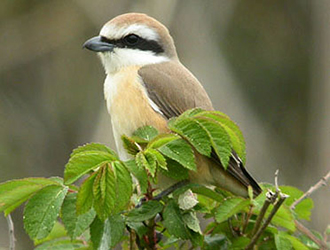
This subspecies, like lucionensis, appears clearly different in the field from all subspecies of Isabelline. While considered to be largely allopatric, Worfolk (2000) suggests that it might meet confusus in Sakhalin, and also records that hybridization between "extralimital" lucionensis and superciliosus has been reported in Japan. Occasional individuals seen in Korea that appear to show mixed characteristics of superciliosus and perhaps confusus or lucionensis (i.e. reddish cap, broad white forehead, brown back and mantle) suggest that hybridisation between superciliosus and other subspecies is perhaps more widespread than presently thought.
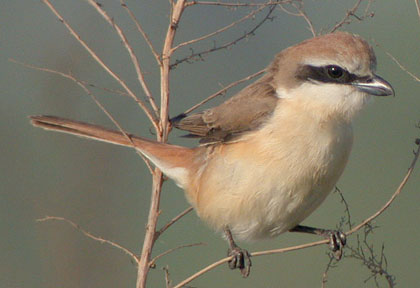
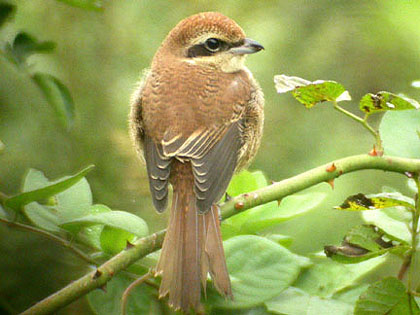
The remainder of reddish-backed individuals are more difficult to ascribe to subspecies, and show great variation. Based on the description in Robson (2000) many of these are likely ascribable to confusus, while others are probably within the range of nominate cristatus (differences between the two are not well-described in available literature. For example Robson [2000] depicts confusus but omits nominate cristatus; while Worfolk [2000] depicts cristatus and has only one image of confusus). Adult nominate cristatus and confusus apparently differ most in the amount of rufous on upperparts, prominence of white supercilium and on average, bill size (Svensson, 1992). Both share strong reddish-brown tones to most of the upperparts, a strong black face-mask, and dark lores (black in males, brownish-black in adult females), and variously warm, even orangey-rust washed flanks and breast sides. All adults show all-dark bills (though sometimes with a faintly blue-grey or paler base), while the tails of many (but not all) individuals appear very slightly graduated, with slightly longer central than outer tail feathers.
Many also show fairly apparent growth bars and also slightly paler buffy-tips to at least the 5th and 6th pairs of tail feathers (as described by Svensson, 1992). Males of both subspecies lack vermiculations (according to Svensson, 1992), while females tend to show variable but weak brown vermiculations or barring especially on the flank and breast sides, and juveniles extensive vermiculations below and above. The majority of juveniles are safely separable from the vast majority of Red-backed and Isabelline Shrikes on the basis of e.g. their already dark lores, and largely uniform reddish-brown upperparts (lacking any grey tones on the nape or mantle, and e.g. any obviously darker tones to the tail).
3) "Sandy-backed" Individuals
At least in 2003 and 2004, small but significant numbers of rather more "sandy-backed" individuals have been noted, comprising very approximately 10% of Brown Shrike recorded in mid- to late May. These quite possibly represent an intergrade or hybrids between lucionensis and the "reddish-backed" subspecies (i.e. mostly confusus) or even perhaps between the "reddish-backed" subspecies and Isabelline Shrike.
Most "sandy-backed" individuals show a rather warmer rufous suffusion to the crown; rather warm, even orangey tones to a square-ended tail (with or without weak growth bars); very striking pale edges to the tertials; typically rather brownish, rather than blackish remiges on the closed wing; a strong black "face-mask" and dark lores, with dark extending to the base of the bill; a dark bill; and buffish underparts, rather paler than in most "reddish-backed" individuals.
Some seem to show a rather weak supercilium, while others perhaps tend to appear closer to superciliosus, with extensive white in the supercilium, extending to the forehead.
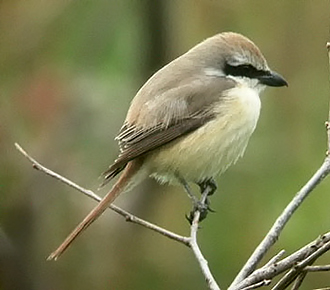
A distinctive-looking individual, apparently lacking both the darker brown upperpart coloration of lucionensis and the reddish-brown coloration of other subspecies. Similar to phoenicuroides Isabelline it showed stronger rufous tones to the crown, and at least 6 or rather more likely 7 primary tips beyond the longest tertial. It however also lacked an obvious white patch at the base of the primaries, and showed buffy tips to the outer tail feathers (considered by Svensson [1992] to be a feature more of Brown than of Isabelline).

Second individual (seen by several observers), also presumably a male based on lore colour and lack of vermiculations. Like the individual in figure 14, it lacked reddish-brown tones to the upperparts (apart from on the crown), and instead showed very striking and "complete" pale fringes to the tertials and secondaries on the closed wing. Different from the bird in figure 14, and more sandy-toned and contrasting above than "typical" cristatus, it showed a strong supercilium, whitish forehead and apparently only 5 primary tips visible beyond the longest tertial.
It would be most interesting to learn if such individuals are frequently observed in other parts of the range, and if so, where in significant concentrations.
Further individuals showing atypical characters: challenges to conventional identification criteria?
Although most Brown Shrike should be easily identifiable to species on a combination of characters, a few individuals show one or more characters that are much more strongly associated with Isabelline Shrike. That such characters can be shown by Brown Shrike seems inadequately referred to in much of the available literature, and as such could well lead to misidentification of some extralimital birds.
1) Individuals with white patches at the base of the primaries
Svensson (1992) states that Brown Shrike very rarely shows a white patch at the base of the primaries, a view echoed by Worfolk (2000), who states there is normally no visible primary-patch but that a few birds show a tiny pale spot at the base of the inner primaries. Personal observations, however, suggest that possibly one in 20 or 30 "reddish-backed" individuals in South Korea identified as Brown Shrike show a reasonably significant patch, perhaps smaller than but still suggestive of Isabelline. Their frequency suggests strongly that they are not all vagrant Isabelline. A perhaps lesser number (including one "sandy-backed" type in 2004), show rather weaker vestigial type patches.
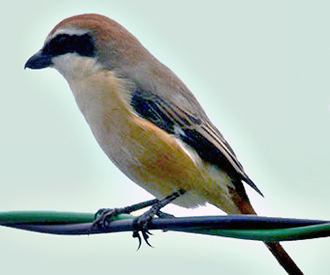



2) Females with pale lores
Although the vast majority of Brown Shrike appear to show dark lores, at least five females seen in the spring of 2004 (out of less than 50 noted as such) showed rather plainer and paler lores, with several of these appearing strikingly pale-lored and "open-faced" (strongly recalling both Isabelline and female Red-backed Shrikes). One such individual in early June also showed a largely pinky-grey base to the bill. Presumably second calendar-year birds, such individuals if found out of their expected range would seem to pose a great identification challenge.

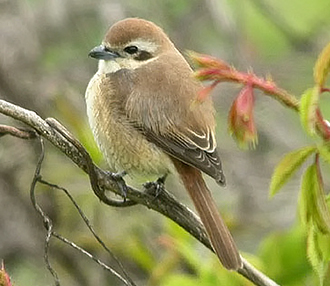
3) Birds with orange-tinged tails
Based on available literature, a pale sandy-brown shrike showing a contrastingly orange-tinged tail is most likely an Isabelline. As Svensson (1992) notes, however, not all Isabelline Shrike show an orange tinge to the tail, while some Red-backed Shrike show rufous tones, and a significant percentage of Brown Shrike also do.
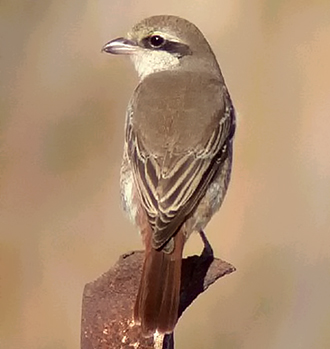
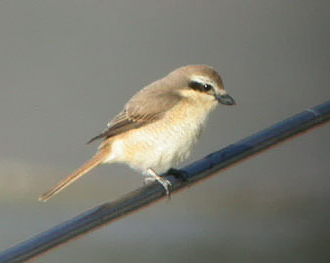
Conclusion
The Brown Shrike is a highly variable species. There seems to be a limited understanding of most non-adult male plumages, with several discrepancies noted between females and immatures seen in the field and descriptions contained within oft-cited literature. In addition, hybridisation between the various subspecies is not well-studied, but it seems, based on the extreme variability of many individuals seen in South Korea and elsewhere, that it might well be rather extensive. This seems to include hybridization at least between superciliosus and lucionensis, and between lucionensis and cristatus (and/or confusus).
Concerning confusus, the literature is rather poor in describing its appearance and it appears to be used either to describe a subspecies in its own right or as a term to cover the extreme variety of intergrades between lucionensis and cristatus (and/or superciliosus).
As noted by Svensson (2003) the closely-related Isabelline Shrike forms a complex "worse than a Magpie’s nest", and it seems rather likely that Brown Shrike does too. Until much more detailed research has been conducted, it seems inappropriate therefore to consider the various taxa of Brown Shrike as full species.
While highly distinctive in "typical" plumages at the extreme ends of each subspecies (i.e. adult male superciliosus, lucionensis and cristatus), there appear to be no consistent structural or biometric differences easily discernible in the field and a very significant percentage of individuals (i.e. the majority, based on Worfolk’s descriptions) appear, in Korea at least, to be intermediate in appearance. Many such individuals cannot yet be safely ascribed to subspecies; and more surprisingly it appears that a very much smaller number perhaps cannot even safely be ascribed to species in field conditions.
Especially considering the existence of hybrids, and the tendency to vagrancy shown by both Brown and Isabelline Shrike, it seems therefore that all extralimital Brown or Isabelline Shrikes, whether considered "typical" or "atypical", need to be identified on the basis of a broad range of characters, preferably supported by in-hand measurements.
Acknowledgements
This online note has benefited hugely from the input of Bjorn Johansson, who not only kindly provided images, sections of relevant papers and extensive personal comment, but also translated some of Lars Svensson’s recent writings from Swedish into English.
Grahame Walbridge also stimulated much of the original motivation for the note.
Recieved Comments:
Updated 24 June 04
Jochen Roeder:
"It really is astonishing how certain some people are in their identification of extralimital brown-redbacked-isabelline shrikes...
In Kazhakstan, I must have been a really lucky birder to find hybrid pairs containing Brown and Isabelline Shrikes in close proximity to each other, and both of these paired with Red-backed!"
For a series of fascinating images and the full text of what Jochen REALLY wrote go to Hybrid Shrikes in Central Asia.
References
- Gibson, D. (1981). Migrant Birds at Shemya Island, Aleutian Islands, Alaska. Condor 1981. 83: 65-77.
- Robson, C. (2000). A Field Guide To the Birds of South-East Asia. New Holland publication.
- Svensson, L. (1992). Identification Guide to European Passerines, 4th Edition. Stockholm.
- Svensson, L. & P. Grant. (1999). Collins Bird Guide. HarperCollins Publishers.
- Svensson, L. (2003) "The quest for the Asian Short-toed Lark." Roadrunner 2/2003: 22-28. (in Swedish, translated by Bjorn Johansson)
- Tomek, T. (2002). The birds of North Korea. Passeriformes. Acta zool. Cracov. 45 (1): 1-235.
- Worfolk, T. (2000). Identification of Red-backed, Isabelline and Brown Shrikes. Dutch Birding 2000. 22: 323-362.
Additional online references
The Rufous-tailed (Isabelline) Shrike http://www.delhibird.org/species/index.htm (follow the link in the left margin)



